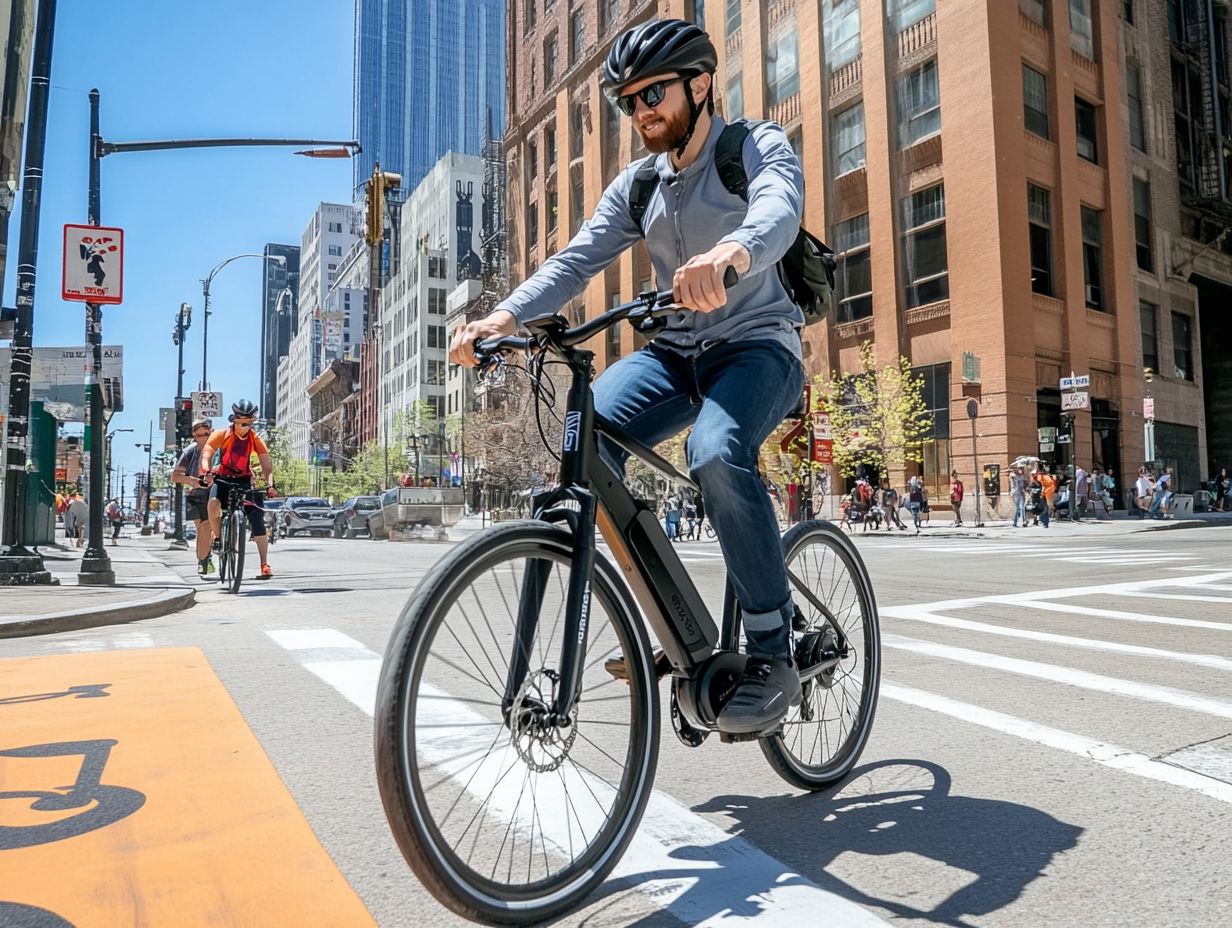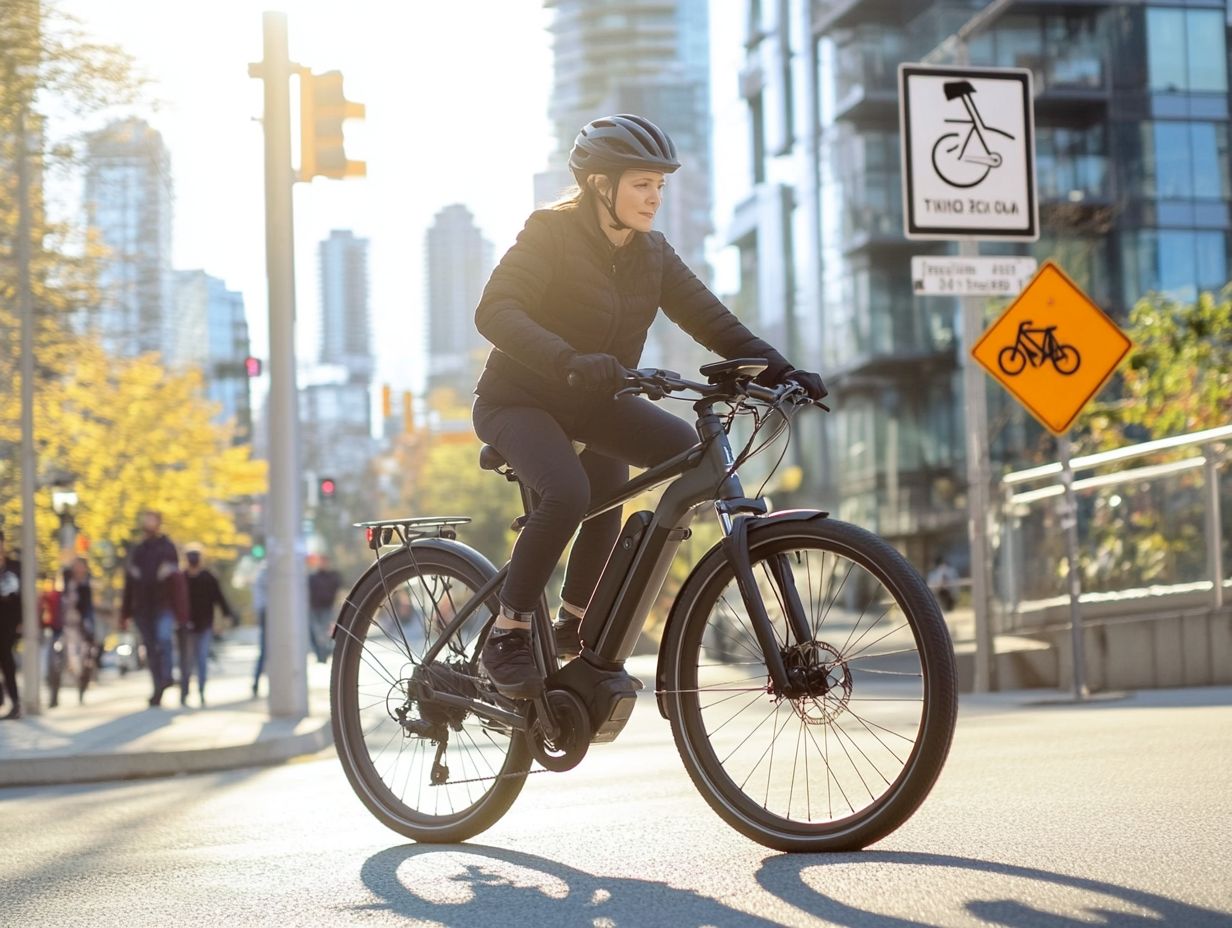How to Stay Compliant with Electric Bicycle Laws
Electric bicycles, also known as electric bikes, are gaining traction in today’s world, but understanding the laws around them can be tricky.
You ll need to understand various classifications and regulations. Staying compliant has its benefits, and there’s a lot to learn!
This article dives into the nuances of electric bike laws, outlines the common e-bike classes available, and provides essential tips for proper use and maintenance.
It also highlights the potential pitfalls of non-compliance and points you toward valuable resources to keep you informed. Discover everything you need for an exhilarating ride!
Contents
- Key Takeaways:
- Understanding Electric Bicycle Laws
- Benefits of Complying with Electric Bicycle Laws
- Common Types of Electric Bicycles
- Tips for Staying Compliant
- Consequences of Non-Compliance
- Resources for Understanding Electric Bike Laws
- Frequently Asked Questions
- What are the basic laws I need to follow to stay compliant with electric bicycle laws?
- Do I need a license to ride an electric bicycle?
- Can I ride my electric bicycle on bike paths and trails?
- What safety gear do I need to wear while riding an electric bicycle?
- Is there an age restriction for riding an electric bicycle?
- Do I need insurance for my electric bicycle?
Key Takeaways:

- Knowing and following electric bicycle laws ensures safety and legal protection for riders.
- Understanding the different types of electric bicycles and properly maintaining them is essential for compliance.
- Non-compliance can result in fines and penalties, so it is important to stay informed and follow traffic laws.
Understanding Electric Bicycle Laws
Understanding electric bicycle laws is essential for you as both a rider and a manufacturer, ensuring compliance with the myriad of e-bike regulations that differ from state to state. These laws can significantly shape the legal landscape surrounding electric bikes.
In the United States, e-bikes are categorized into different classes Class 1, Class 2, and Class 3 based on specific criteria such as help you pedal, a device that helps you go without pedaling, and maximum speed limits. Each of these classifications must align with the safety standards established by regulatory authorities like the Consumer Product Safety Commission. For those in California, it’s essential to be aware of the understanding electric bicycle laws to ensure compliance.
Classification and Regulations
Understanding how electric bikes are classified is key to knowing the rules that apply to you. You’ll encounter distinct e-bike classes Class 1, Class 2, and Class 3 all governed by specific state regulations and local authorities.
These classes vary based on maximum speed, power output, and the requirement for pedaling. For example, Class 1 e-bikes, which only offer assistance while you’re pedaling, tend to be widely accepted in many states, including California, where regulations are generally more lenient.
Class 2 models, which come equipped with a throttle, are also common; however, certain areas may necessitate registration and licensing for their use.
On the flip side, Class 3 bikes, which can reach speeds of up to 28 mph, often face stricter regulations and may even be banned from bike paths. Local authorities play a vital role in enforcing these classifications, ensuring that e-bike users adhere to safety protocols. For more tips on ensuring compliance, check out this guide on how to maintain safety features on your electric bicycle, ultimately fostering a safer riding environment for everyone.
Benefits of Complying with Electric Bicycle Laws
Complying with electric bicycle laws brings a host of advantages. You gain enhanced safety standards that protect riders, along with legal safeguards against potential liabilities should accidents or injuries occur.
Complying keeps you and other riders safe, creating a better experience for everyone.
Safety and Legal Protection
Safety and legal protection are crucial when you re riding electric bicycles. By understanding the right safety equipment and e-bike safety tips, you can significantly decrease your chances of accidents and injuries.
Investing in a quality helmet is a must after all, it s your first line of defense against head injuries. Luckily, there are plenty of stylish options available that prioritize both comfort and aesthetics.
Reflective clothing is another vital piece of your safety arsenal; it boosts your visibility in low-light conditions, making sure that motorists can spot you easily.
Following local traffic laws not only keeps you safe but also helps you avoid any legal headaches should an incident occur. Simple, practical tips like signaling your turns, maintaining a safe distance from vehicles, and riding defensively can elevate your safety game even further.
By equipping yourself with the right gear and sticking to the rules, you can ride your e-bike with confidence and peace of mind.
Common Types of Electric Bicycles

In terms of electric bicycles, you ll encounter various e-bike classes, including Class 1, Class 2, and Class 3.
Each class has unique features, such as pedal-assist (which means the motor helps you pedal) and throttle-assist. These distinctions enhance your riding experience and make these bikes excellent choices for eco-friendly transportation.
Differences in Design and Usage
The design and usage differences among electric bicycles stem from their classifications. Class 1, Class 2, and Class 3 each offer distinct features that influence their environmental impact and your overall riding experience.
Class 1 e-bikes provide a smooth experience, relying exclusively on pedal-assist. This feature activates the motor only when you re pedaling, making them perfect for fitness enthusiasts.
Class 2 e-bikes introduce throttle-assist, allowing you to engage the motor without pedaling. This is especially advantageous for those with physical limitations or those looking to enjoy a leisurely ride.
Finally, Class 3 e-bikes combine the best of both worlds. They appeal to commuters who want speed without harming the environment. This contributes significantly to sustainable transportation options, making your choice responsible.
Tips for Staying Compliant
To remain compliant with electric bicycle laws, familiarize yourself with e-bike regulations. Being diligent helps ensure that your electric bike meets safety standards and adheres to all legal requirements.
Proper Use and Maintenance
Proper use and maintenance elevate your bike’s performance and ensure compliance with regulations. This leads to a more enjoyable and safe ride.
Don t wait! Make battery care a priority. Regularly charge it and store the battery in a cool, dry place to prolong its lifespan.
Tire maintenance is equally vital. Check tire pressure before each ride to prevent flats and enhance efficiency.
Routine inspections of brakes, lights, and other components are essential. They help you catch potential issues early, significantly reducing the risk of accidents. By following these best practices, including understanding helmet laws and navigating electric bicycle licensing requirements, you foster a responsible riding culture while promoting safety for everyone on the road.
Following Traffic Laws
Following traffic laws is essential for electric bike riders. It’s crucial for legal compliance and the safety of everyone on the road.
Being aware of local regulations and road rules can help prevent accidents. You’ll typically be required to use bike lanes whenever available and obey traffic signals just like any vehicle. Additionally, it’s important to know how to ensure your electric bicycle is road-ready. In many areas, wearing a helmet and having functioning lights, especially at night, is mandatory.
By adhering to these rules, you significantly contribute to safer road environments, reducing collisions and fostering a culture of safety and respect among all road users.
Consequences of Non-Compliance

The consequences of not adhering to electric bicycle laws can be quite serious. You may face penalties for violations, encounter heightened risks of accidents and injuries, and find yourself without legal protections in the event of an incident.
Stay informed and keep riding safely your safety and enjoyment depend on it!
Possible Fines and Penalties
Possible fines and penalties for electric bike riders who don t adhere to e-bike laws can vary significantly based on state regulations and the specific violations committed.
Take California, for example: riding an electric bike without a helmet could land you with a fine of up to $250. In contrast, New York City takes a tougher stance, with fines soaring to $1,000 for riding a modified bike. For more information on the legal aspects, consider reviewing the key legal considerations for electric bicycle riders. These financial repercussions act as a powerful deterrent, compelling riders to comply with the laws.
When you realize that violations can result in steep fines and higher insurance rates, you re more likely to follow the rules of the road.
Knowing the rules not only keeps you safe but also makes the roads safer for everyone!
Resources for Understanding Electric Bike Laws
Accessing the right resources for understanding electric bicycle laws can significantly aid you, whether you’re a rider or a manufacturer, in understanding e-bike rules.
This knowledge is essential for ensuring compliance with the official guidelines set forth by local authorities and government organizations that set rules.
Where to Find Official Guidelines and Support
Finding official guidelines and support for electric bicycles is crucial for ensuring you comply with e-bike regulations. Local authorities and regulatory bodies often provide valuable resources and information that can make all the difference.
This becomes especially important when you want to grasp the specific laws that apply in your area, as regulations can vary significantly from one region to another. Most state government websites feature dedicated sections on transportation, which include e-bike regulations, allowing you to easily access the current laws. Local transport authority resources provide up-to-date information on safety requirements, designated lanes, and any restrictions that may apply, including Understanding Electric Bicycle Safety Regulations.
Cycling organizations frequently compile these guidelines into user-friendly formats, fostering awareness and encouraging responsible riding practices. This collective effort ultimately contributes to a safer cycling environment for everyone involved.
Frequently Asked Questions
What are the basic laws I need to follow to stay compliant with electric bicycle laws?

To stay compliant with electric bicycle laws, you need to follow basic traffic laws such as stopping at red lights and stop signs, riding with traffic, and using hand signals when turning.
Do I need a license to ride an electric bicycle?
In most states, you do not need a license to ride an electric bicycle as long as it meets certain criteria such as maximum speed and power limits. However, it is always best to check with your local laws to ensure you are following the proper regulations.
Can I ride my electric bicycle on bike paths and trails?
This depends on your local laws and regulations. In some areas, electric bicycles are allowed on bike paths and trails, while in others they are not. It is important to research and follow the rules in your area to stay compliant.
What safety gear do I need to wear while riding an electric bicycle?
Just like riding a regular bicycle, it is important to wear a helmet while riding an electric bicycle. Additionally, wearing reflective clothing and using lights and reflectors on your bike can help increase visibility and keep you safe.
Is there an age restriction for riding an electric bicycle?
Again, this depends on your local laws. In general, most states allow individuals 16 years and older to ride an electric bicycle without any restrictions. However, it is always best to check with your state’s laws to ensure you are following regulations.
Do I need insurance for my electric bicycle?
While not required in most states, it is always a good idea to have insurance for your electric bicycle. This can protect you in case of accidents or theft. You can contact your insurance provider to inquire about coverage options for electric bicycles.
Make sure to check your local laws today to ride safely and legally!






